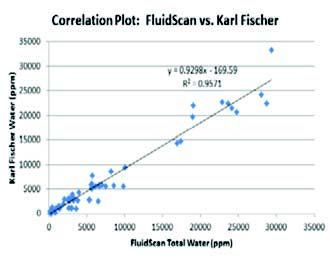On-site oil analysis
SELF-SERVICE ANALYSIS CAN ELIMINATE THE NEED TO SEND SAMPLES TO AN OUTSIDE PROVIDER
Tests for vibration and other parameters are frequently performed on turbomachinery. However, oil analysis tests are carried out less so, perhaps because of the effort involved in collecting samples that have to be sent to off-site testing providers. The subsequent lag time in obtaining results is often too long to be effective in decision-making. With demands to increase efficiency, lower maintenance costs and improve equipment uptime, oil analysis programs are coming under scrutiny at power generation plants. The latest on-site oil analysis technologies make it possible for maintenance personnel to conduct these tests themselves.
The amount of oil samples generated by the plant affects the decision to continue the existing practice of sending samples to an outside provider or investing in an on-site oil analysis program. A good rule of thumb is to use MW capacity. For those plants with capacities below 150 MW and performing less than 200 samples per year, it makes sense to continue sending those samples to a lab. Above that, an on-site program will be more efficient and cost effective.
Figure 1: FluidScan Handheld IR Analyzer water results compared to traditional Karl Fisher laboratory method

To gain a perspective of how much machinery requires oil analysis in a combined cycle power plant, consider that on average each turbine generator includes: a steam turbine; two boiler feed pumps; up to six condensate pumps; up to six feed water booster pumps; up to six circulating water pumps; two induced draft fans (or forced draft fans, motors and gearboxes); two gas recirculation fans motors and gearboxes; up to ten cooling towers fans motors and gearboxes; as well as a great many additional pumps, fans and compressors. A large power plant with four generating units, therefore, may have several hundred oil-lubricated components that have to be sampled on a periodic basis.
Which tests?
Power plant operators new to oil analysis can become confused about what tests are important. Umbrella specifications for power plant lubrication, such as ASTM D4378 and ASTM D 6224, define almost every test used to qualify lubricants for the application. These standards serve as a guide for central chemistry laboratories supporting many generating units. But it can still be difficult to distinguish the most important tests that can be done onsite. Here are some of the more vital ones:
• Particle counting
A measure of oil cleanliness, particle counting is a critical test for hydraulics, turbines and filtered gearboxes. This test has evolved to be more than a measure of effective filtration. Newer technologies such as LaserNet Fines count particles and report to ISO 4406 or SAE AS 4059. They also provide more detail to understand where particles come from. Particle imaging enables maintenance staff to see sand and dirt particles and the level of ferrous debris contributing to the count.
• Water contamination
Water is the most common liquid contaminant in power plants, and should always be monitored. Excessive water destroys a lubricant’s ability to separate opposing moving parts, allowing severe wear to occur. For most equipment water contamination should not exceed 0.25%, and not more than 100 ppm for turbine lube and control systems. A number of new technologies are available to detect water contamination in lube oils, and on-site results correlate with laboratory techniques (Figure1).
• Kinematic Viscosity
Viscosity is a lubricant’s most important physical property. Lubricants must have suitable flow characteristics so an adequate supply reaches lubricated parts at different operating temperatures. Their viscosities vary depending on classification, grade, oxidation and contamination. In power plants, viscosity is routinely measured right after an oil change to confirm the correct oil was added, as well as on a periodic basis. The kinematic viscosity test deals with the resistance of a fluid to flow under gravity. Solvent-free, low-volume testing systems are available that combine ease of use with data logging ability.
• Total Acid Number
Total acid number (TAN) indicates relative acidity. Oil changes are often indicated when the TAN value reaches a predetermined level. An abrupt rise in TAN would be indicative of abnormal operating conditions. In turbomachinery operation, oxidation products accumulate, causing the oil to become degraded, and in most instances, slightly acidic. If oxidation becomes severe, the lubricant will corrode critical surfaces. The greater the “oxidation number,” the more oxidation is present. Similarly, the “nitration number” reflects the level of nitrogen compounds in the oil resulting from nitrogen fixation (common in natural gas-fueled engines). Conditions such as varnishing, sludge deposits, sticky rings, lacquering and filter plugging can result.
Portable infrared spectroscopy will trend these parameters and indicate contamination due to free water, glycol antifreeze and soot deposits. Varnish deposits still concern turbine maintainers working with API Group 2 oils. Simple filter and color photospectrometers used on-site help to determine if a varnishing situation is taking place.
• Atomic emission spectroscopy
This technique for detecting and quantifying metallic elements is the backbone for all lab oil analysis. The oil sample is energized to make each element emit or absorb a quantifiable amount of energy, which indicates element concentration in the oil. The conclusions reflect the concentration of dissolved metals (from additive packages) and particulates. Until recently, it was not considered a suitable on-site test because the equipment was developed for lab technicians. However, rotating disk spectroscopy (RDE) technology is available to quickly test on-site for 24 elements.
On-site tools and solution packages for all of the above tests are available to power generation sites. Be aware, however, that an “all-in-one” approach provides too much data to be practical in some plants. It is best, therefore, to start with basic on-site analysis and add more analytical capability as needs dictate. By bringing this function onsite, plant personnel can save valuable time in diagnosis of potential issues.